Dancing with scientists is awkward and hard. We have norms around what is seen as “professional” behavior. Franklin encouraged us to challenge this — pushing us out of our comfort zones.
Lindsay: I am co-principal Investigator on a USDA Forest Service (USFS) research project called “Fueling Adaptation” which is looking at wildfire communications, governance, and adaptation as part of the Wildfire Crisis Strategy. This is work I co-lead with Miranda Mockrin (USFS) and Cody Evers (Portland State University). Our team of social scientists and practitioners met in person for the first time in November 2023 in Denver, after a year of working together virtually to prepare, to kick off the next two years of work. We spent one day in Jefferson County with wildfire response professionals touring various sites in the wildland-urban interface (WUI) and two days meeting, presenting, and collaboratively working on synthesis at CU Denver, hosted by Austin Troy.
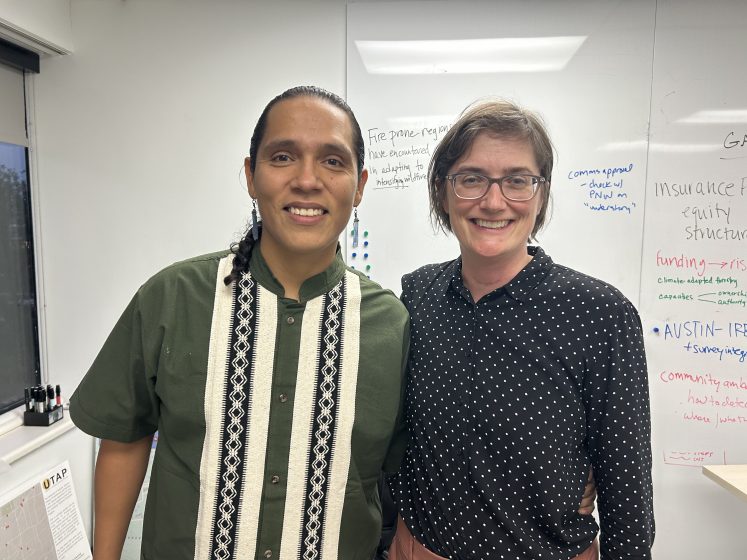
The-PIs agreed to invite Franklin Cruz, an Urban Field Station Artist in Residence, to lead an arts-based exercise as part of our workshop. I have to say that just taking this first step was a leap of faith for my colleagues — they had never done any sort of arts-engaged work as part of a meeting, so they were curious but willing to experiment. I think a willingness to experiment or take a leap is key to this. Another key factor is that Travis Warziniack was willing to offer some of the Denver UFS resources with The Nature of Cities to support Franklin’s time. I’m grateful to Travis for making this possible. I admit that even as PI of a project, I had not built in a budget for this sort of experimentation and that is a lesson learned for me.
We had a Zoom conversation with Franklin and I shared our overarching objectives, described our team and our meeting, and shared a project 2-pager that had our main research questions on it. Franklin offered us a range of options and experiences — from shadowing our group and producing a piece of poetry about our work to a more immersive half-day workshop with other dancers brought in to reflect on wildfire adaptation, to what we settled on which we thought of as an “introductory” step, which was a one hour, somatic and movement based experience that our team would participate in. We both agreed that our team would be tired from sitting in a conference room all day, working with intense cognitive focus, and reconnecting with our bodies would be an important step. Particularly when we think about the heavy emotional resonance and magnitude of the wildfire crisis — we wondered what it would go to our research team to have this shared, embodied experience together.
I can honestly say that dancing with scientists is awkward and hard. We are so used to seeing ourselves as just zoom boxes (disembodied heads), or maybe as bodies in chairs. We have norms around what is seen as “professional” behavior. Franklin encouraged us to challenge this — pushing us out of our comfort zones. Even as a former athlete and a person who likes to dance, it was hard to stop blushing, hard to move past embarrassment. There were many awkward laughs. But Franklin made it easy, leading us through a series of directed exercises.
I will never forget the experience of locking eyes with my colleague, Research Ecologist Michelle Johnson, as we jubilantly danced out a representation of wildfire that was allowed to burn — far away from homes and lives, as we represented visions for the future. Meanwhile, Austin Troy was wiping away unfettered development with a flick of his arms. Dancing allowed us to DREAM and IMAGINE in ways that we absolutely do not as scientists. By the end of the workshop, I actually felt like I was dancing — hearing the music for the first time, and not worried about how folks were perceiving me. I had reconnected with my body.
I asked my fellow PIs for their thoughts, and here’s what Cody shared:
“I was reminded of the challenge of feeling comfortable and free to dance. I was surprised when Franklin asked us to communicate through movement answers to really cerebral questions so closely tied to our project. At first, it seemed like a game of charades – a somewhat awkward way of addressing these issues! I felt these questions are clearly best handled through words and thoughts. But then I realized that perhaps this was a bias that had been impressed on me and that my inability to articulate thoughts through movement was more about my illiteracy in this language rather than the language itself. While I don’t feel that I was able to transcend this barrier, the experience felt like an important realization of how “art can guide science”.
Franklin responded with their thoughts on the collaboration:
Franklin: I was intrigued with this collaboration because of my work integrating science and art at the institutional level. I’m excited to get nerds to play and creatively experiment because I’m a sucker for homo sapiens. My initial thoughts are about the process I’m familiar with: an introductory phase to build comfort and a base vocabulary then shift to an artistic storytelling phase and finishing with a critical graduate-level application. My favorite part is watching limits be broken whether creatively, personally, or philosophically. I see shy folks begin to access introvert power with simplicity, extroverts gather energy. I see strong cerebral folks struggle with being somatic and often do the entire time; compatibility with the art is a variable. Many see the thread of logic to the process and outcome. Everyone usually ends up in their body regardless of the journey asking questions often overlooked and minimized because of professionalism, cognitive fatigue, or simply desensitization to our own somatic experience.
Construction of the workshop is a tried and true practice for me. The questions the organization is tackling weren’t difficult to interpret from the two-page material provided and the conversations with Lindsay. My background in biology and ecology helps immensely with understanding the audience I’m working with. The difficulty is finessing the facilitation; being grounded and prepared to receive unwariness, excitement, and guidance into the high-level application of creative practices for mission-relevant outcomes. I wanna balance the play and expertise of our communities. Regardless of the science or resource management practice, fire has an emotional, social, and ecological impact. Your body is the instrument that processes that information and we hardly practice using the full toolkit.
It becomes a practice of pulling ethos from logos through pathos. Feeling for this particular workshop is essential. Critically we cannot abandon our real-world issues to just dance; movement offers an alternative way of thinking theoretically in a format of infinite possibilities. We reconnect with our deep motivators, critically thinking about impact and playing pretend where we can make anything happen. How would we tackle issues if we build from such a somatically informed base? What would we identify as quick solutions if we connected to our body’s intelligence? Somatically processing is a skill and what does it teach us that cerebral processing isn’t attuned to?
Robin Wall Kimmer in Braiding Sweetgrass reminds us we are mutualistic with many ecosystems when we’re balanced as a species. Her practices balance art and science and this is the model I am inspired by. My Mexica (Meh-shee-ca) elders remind me that adding beauty to the world is symbiotic too and making it mutualistic is difficult, not impossible. Observing my mentors and elders I honor my niche and adaptations, I know my ecosystem, I’m aware of the socio-cultural biosphere, and am most fertile artistically. Seeds spreaders help forests grow, I apply my skills similarly taking seeds from different forests to another. Whether they sprout, mature, make populations or communities, and develop into old forests isn’t my responsibility.
I want to express the gratitude I have for Lindsay and Travis for funding this work because it appreciates the craft and legitimizes the role it has in science. I am a practiced professional and trained extensively over a decade to develop this skill. I’m moved by the comments from Cody above. It is the outcome I deeply desired. I always say I’m not here to make you artists or dancers, I’ve learned so much from my friends that I just want to synthesize the skills we can all learn from as homo-sapiens and see these skills as pathways to envision and direct our communities to an unimagined world that we feel. Any art will do and I always bring writing, movement, culture, nature, and spirity stuff. It’s who I am and my body tells me.
Lindsay: I have many reflective questions as the meeting organizer. We had planned to have this at the end of day 2 as a reset/interrupter before our last day of synthesis, but due to some logistical hiccups we had to move it to the end of day 3, so this meant we didn’t have participation of our full group. It worked as a lighthearted, “send off” to the meeting — but I wonder what work it would have done in its original spot in the agenda? How could I have done more to build off this shared experience and scaffold upon it? Should I have done a formal evaluation? Should I have invited Franklin into more of the meeting? Should I have created a transdisciplinary research question as part of the work from the outset? Would any agency ever fund that? Or is it okay that it was “just an excercise?”
At a minimum, the workshop was a source of team-building and bonding and an alternate way to get to know each other more deeply. More than that, it reminded us that we TOO are human animals, with sensing bodies and feelings. Ideally, it helps us better envision our north stars – why we are in this wildfire research work — and what would a transformed world really look, move, and feel like? Thank you Franklin and to my colleagues for being willing to experiment with me!
about the writer
Franklin Cruz
Franklin Cruz is a queer Latin dancer, poet and environmental nerd born in Idaho, raised Texan and polished in Denver. Born from an immigrant family their work has placed them in science museums, as an emcee for dance & poetry competitions, conferences and environmental spaces. A Tedx Mile High performer and Nature of Cities residency, he worked throughout the southwest, Peru, Puerto Rico for universities and environmental leadership camps. Their work encompasses self love, immigration, culture, conservation and more.
Lindsay Campbell and Franklin Cruz
New York City and Denver
Banner image: “Scientist Harvest Dance” by David Maddox, 2024. Collage. Cut paper, clippings, and computer manipulation.


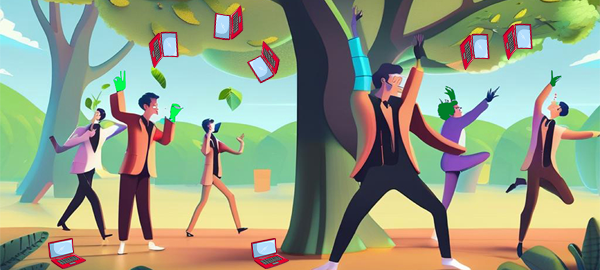
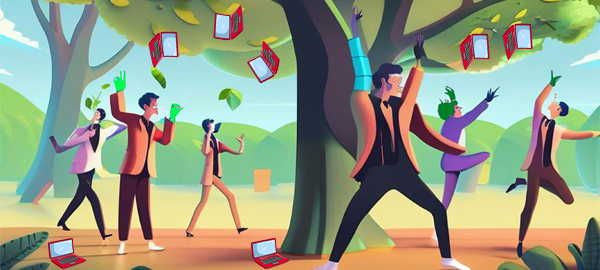
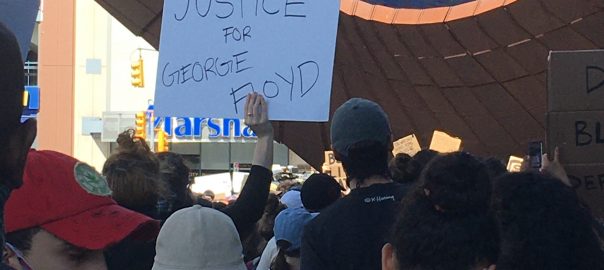
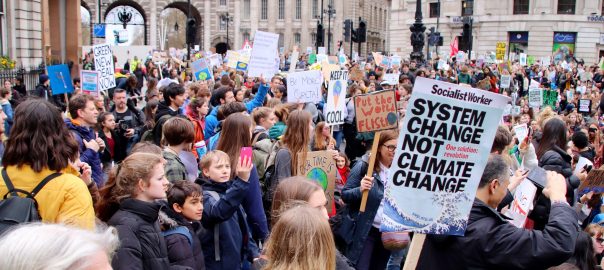
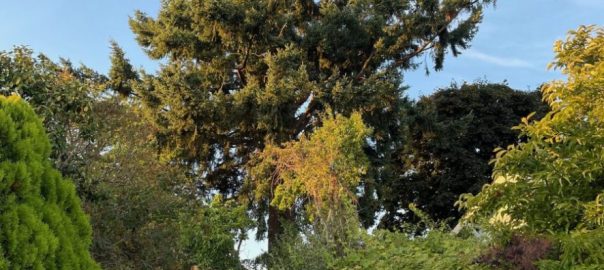
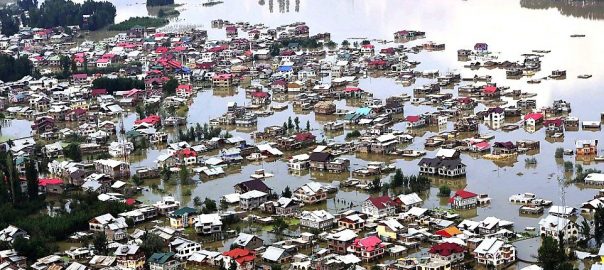
Leave a Reply